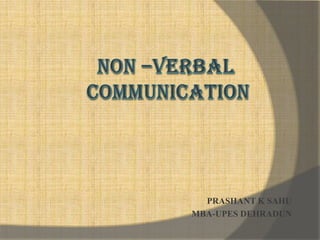
NON VERBAL COMMUNICATION
- 1. Non –Verbal Communication PRASHANT K SAHU MBA-UPES DEHRADUN
- 2. INTRODUCTION Non-Verbal (non word) communication means all communication without words. Nonverbal communication (NVC) is usually understood as the process of communication through sending and receiving wordless messages. The ability to understand and use nonverbal communication is a powerful tool that will help you connect with others, express what you really mean, navigate challenging situations, and build better relationships at home and work.
- 3. Studies show that during interpersonal communication 7% of the message is verbally communicated while 93% of the message is non-verbally transmitted. Of the 93% non verbal communication, 38% is through vocal tones, 55% is through facial expressions and non-verbal acts.
- 5. Roles in Non-Verbal Communication Nonverbal communication cues can play five roles: Repetition: they can repeat the message the person is making verbally Contradiction: they can contradict a message the individual is trying to convey Substitution: they can substitute for a verbal message. For example, a person's eyes can often convey a far more vivid message than words and often do Complementing: they may add to or complement a verbal message. A boss who pats a person on the back in addition to giving praise can increase the impact of the message Accenting: they may accent or underline a verbal message. Pounding the table, for example, can underline a message.
- 6. Types Of Non- Verbal Communication BODY LANGUAGE CLOTHING/ARTIFACTUAL COMMUNICATION VOICE /PARALANGUAGE SPACE DISTANCE/PROXEMIC FACTORS COLOUR TIME/CHRONEMICS TOUCH/HAPTICS
- 7. Body Language “The bodily gestures, postures, and facial expressions by which a person communicates nonverbally with others” -(Soukhanov 1992:211). KINESICS: POSTURE GESTURE FACIAL EXPRESSIONS GAZE / EYE CONTACT
- 9. Body Language Facial expression(s) Eyes Lips Arms Hands Fingers legs
- 10. The Face Since the face cannot be easily hidden, it is an important source of nonverbal information and communicates a variety of emotions. In addition, eye contact, pupil size, and the smile provide additional cues to informed observers.
- 12. Eyes
- 13. Lips
- 16. Fingers
- 18. If someone is seated and their legs are fully extended, this indicates the subject is losing interest.
- 19. Crossed legs tend to seem disagreement.
- 21. Responsive ENGAGED leaning forward Open Body Open Arms Open Hands EAGER (sprint position) Open Legs Feet under Chair On Toes READY TO AGREE closes papers Pen Down Hands Flat on Table
- 22. Reflective LISTENING with head tilted Lots of Eye Contact Nodding High Blink Rate EVALUATING : sucking glasses / pencil Stroking Chin Looking Up and Right Legs crossed Ankle on Knee ATTENTIVE (standing) Arms behind Back Smile Open Feet
- 23. SPACE Have you ever felt uncomfortable during a conversation because the other person was standing too close and invading your space? We all have a need for physical space, although that need differs depending on the culture, the situation, and the closeness of the relationship. You can use physical space to communicate many different nonverbal messages, including signals of intimacy, aggression, dominance, or affection.
- 24. LOOKING NERVOUS Crossed arms and legs Carrying books or papers across your chest Slumped posture Sitting perched on the edge of the chair Tapping foot Rocking leg Drumming fingers Biting nails
- 25. Paralanguage Paralanguage, meaning “like language”. sometimes called vocalics) is the study of nonverbal cues of the voice. Various acoustic properties of speech such as tone, pitch and accent, collectively known as prosody, can all give off nonverbal cues. Paralanguage may change the meaning of words.
- 26. Difficulties with nonverbal communication People vary in their ability to send and receive nonverbal communication. Thus, on average, to a moderate degree, women are better at nonverbal communication than are men. Measurements of the ability to communicate nonverbally and the capacity to feel empathy have shown that the two abilities are independent of each other. For people who have relatively large difficulties with nonverbal communication, this can pose significant challenges, especially in interpersonal relationships. There exist resources that are tailored specifically to these people, which attempt to assist those in understanding information which comes more easily to others. A specific group of persons that face these challenges are those with autism spectrum disorders, including Asperger syndrome.
Notes de l'éditeur
- FORWARD